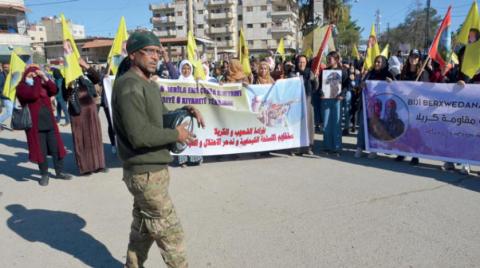
The UN-aligned body that oversees chemical weapons use has for the first time blamed the Syrian regime for using sarin gas on the battlefield in a report hailed by rights groups as a landmark moment with implications for war crimes investigations.
The report, released on Wednesday by the Organisation for the Prevention of Chemical Weapons (OPCW), accuses the Syrian Air Force of twice using sarin to attack the town of Ltamenah in late March 2017. It also found that regime aircraft had bombed the same town with chlorine gas in the same week.
The three attacks took place days before the infamous sarin gas attack on the nearby town of Khan Sheikhoun, which produced some of the most shocking images of the nine-year war and one of its most bitterly contested narratives.
OPCW investigators found that the three Ltamenah attacks took place on 24, 25 and 30 March; the first and third strikes were carried out by SU-22 jets and the second by a helicopter. All three aircraft launched from the nearby Shayrat airbase.
The investigation determined the type of munitions used to deliver the poison gas, and the names and ranks of the Syrian officers who ordered the attacks, although it redacted their identities from the final report.
The report said all alternative scenarios for the casualties, which affected more than 80 people, were considered, including whether the attacks had been staged. But they had been dismissed due to the weight of evidence supporting the finding that Syrian pilots had dropped sarin on the town on the orders of senior officers.
In the aftermath of the Khan Sheikhoun attack, which killed 89 people, loyalists of the Syrian regime and the Russian government rushed to push a narrative that distressing scenes of dead and dying victims had been staged by rescuers. While not focusing on Khan Sheikhoun in this report, the OPCW said similar claims surrounding Ltamenah had been examined. It found that accounts from victims had been corroborated by interviews, which had also been supported by chemical analyses of samples retrieved from the sites.
Jerry Smith, a former OPCW investigator, said the investigation was an important moment in an ongoing effort to bring to account perpetrators of war crimes in Syria.
“To get to this point is long awaited by a big section of the international community”, he said. “It [the report] has named names, identified organisations and given a high level of specificity on at least three of these events. I suspect the US and others will ask for an executive council meeting of the OPCW. Russia doesn’t have a veto there, so it will be just a straight vote.”
Until last year, the OPCW did not have the mandate to apportion blame for chemical attacks. However, a 2018 resolution called for the organisation to be given the right to do so, and the findings are the result of a new body within the organisation, known as the Investigation and Identification team.
Hadi Al Khatib, founder and director of Syria Archive, said: “Now that the report has explicitly pointed to the Syrian government as the perpetrator of these attacks, strong cooperation between states is necessary to ensure that these atrocities are not met with impunity.
“It is time for competent prosecutors to jointly investigate the Syria chemical weapons programme and issue arrest warrants against senior government officials in the Syrian regime.”
Ltamenah, at the time of the attack, was an important logistical hub for opposition groups, who had in previous weeks launched devastating attacks against the regime-held city of Hama. Both Ltamenah and Khan Sheikhoun were used as a supply point for militias opposed to the Assad regime. With extensive help from the Russian Air Force, both towns have now been recaptured by Syrian and allied forces.
Additional reporting by Mohammed Rasool












